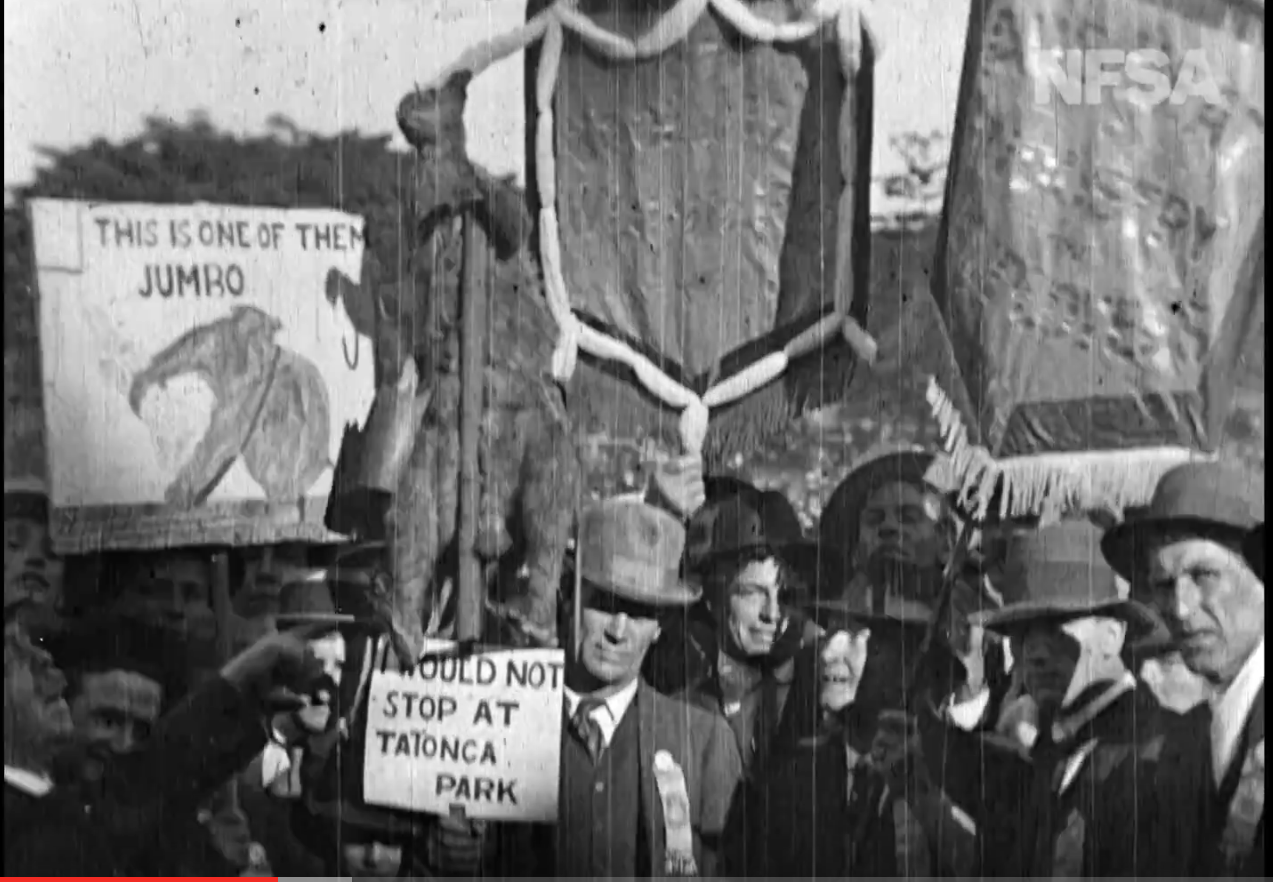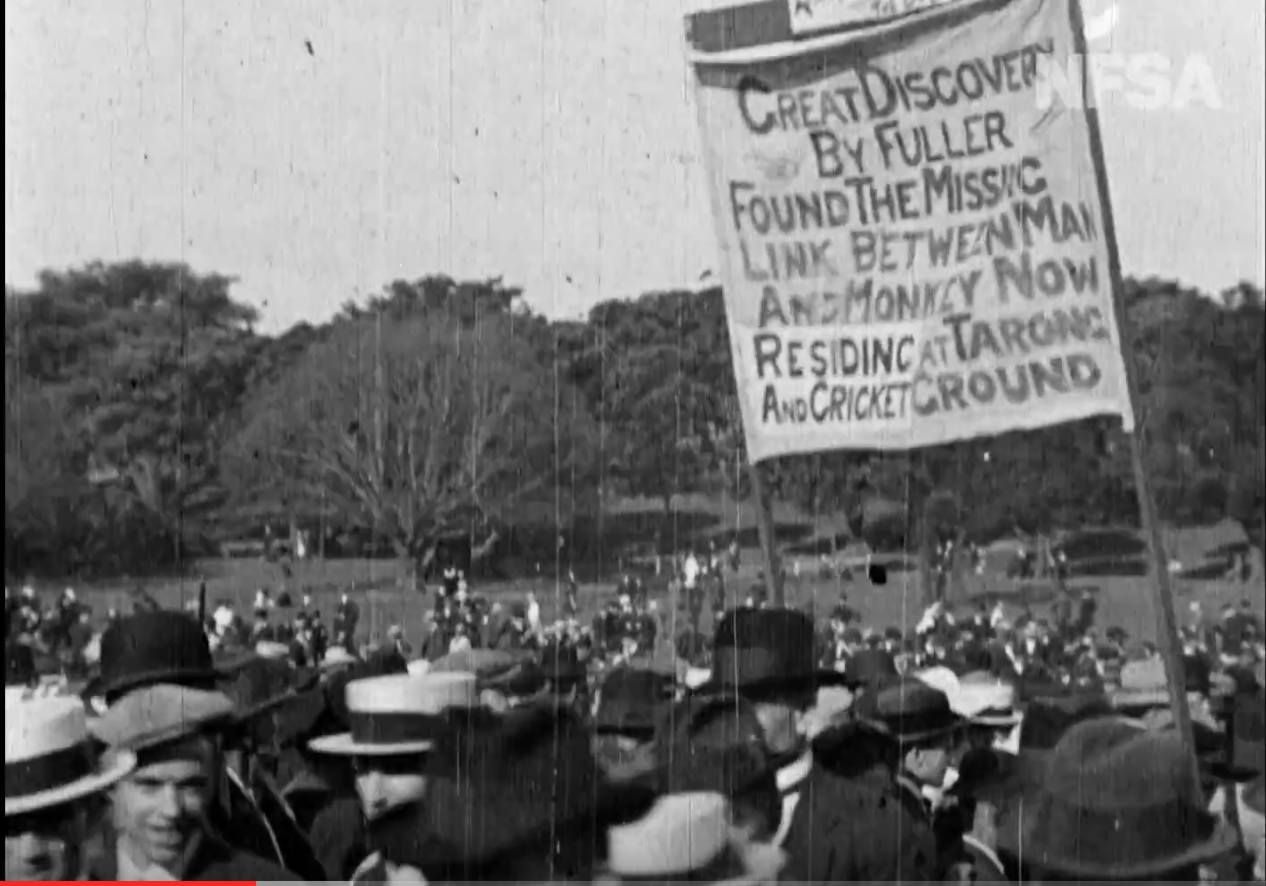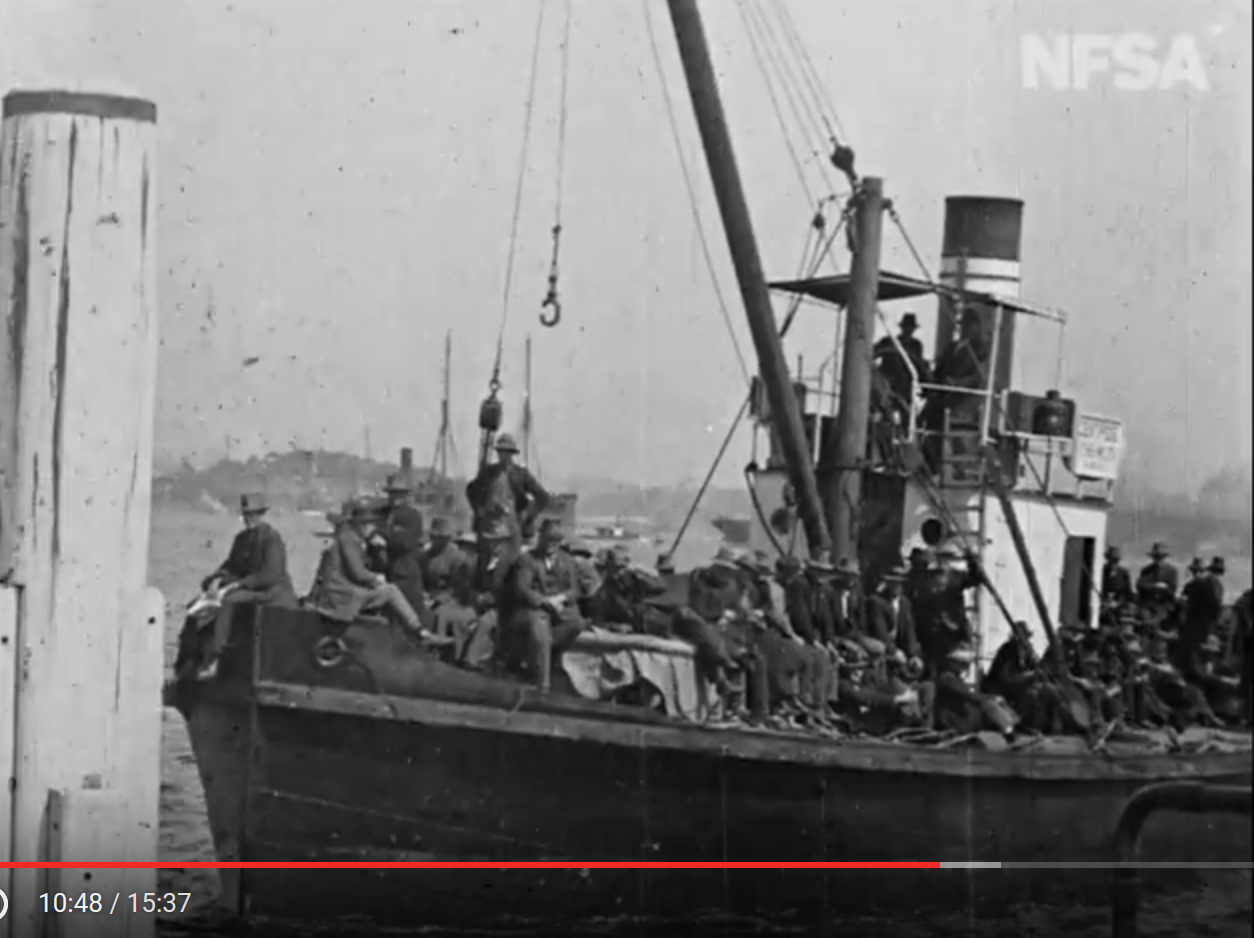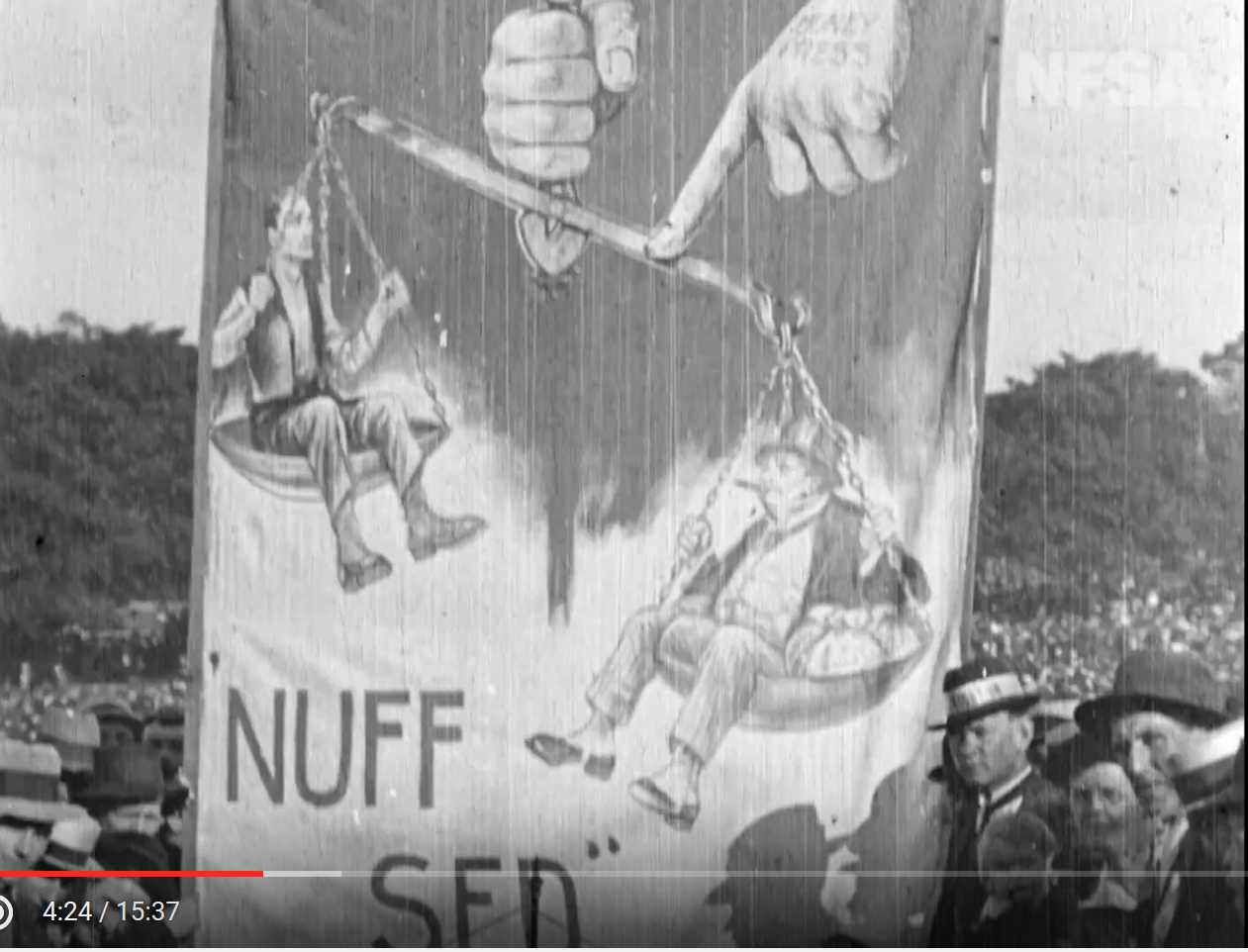 Screen shot from Great War (1917) film reconstructed by National Film & Sound Archive experts. The protest placards make reference to the strike-breakers residing at Taronga Zoo.
Screen shot from Great War (1917) film reconstructed by National Film & Sound Archive experts. The protest placards make reference to the strike-breakers residing at Taronga Zoo.
In 1917, disenchantment with the war and falling living standards led to arguably the greatest industrial unrest in Australia’s history.
The Labour movement organised huge demonstrations in Melbourne and Sydney, attracting crowds of up to 150,000 people. The Labour Party and Unions wanted to enshrine fair pay and conditions. The IWW (or Wobblies) wanted a revolution.
Strikebreakers were called in. According to Historian, Joan Beaumont:
Responding to patriotic calls from the conservative press, volunteers …streamed to the cities wharves and coal mines. Improvised barracks sprung up in locations like Taronga Park Zoo and the Sydney Cricket Ground – which strikers promptly named Scabs Collecting Ground.
 Screen shot of Great War (1917) film reconstructed by NFSA experts. The protest placards make humorous reference to the Zoo’s use as a strike-breakers camp.
Screen shot of Great War (1917) film reconstructed by NFSA experts. The protest placards make humorous reference to the Zoo’s use as a strike-breakers camp.
In all, the governments were able to organise some 170,000 man-days of strike-breaking labour, far fewer than the three million strike days lost but still enough to keep essential services going.1
The National Film & Sound Archive has released film footage marking the 100th anniversary of the 1917 strikes. Of great interest are images of protesters with placards decrying the use of the Zoo as a strike-breakers camp. The film also shows scenes at the North Shore Gasworks and strike-breakers returning by ferry.
 Screen shot of strike-breakers returning by ferry to Taronga Zoo. From Great War (1917) reconstructed by the National Film & Sound Archives.
Screen shot of strike-breakers returning by ferry to Taronga Zoo. From Great War (1917) reconstructed by the National Film & Sound Archives.
The Loyalists.
 Strike-breakers on Taronga Wharf, 1917. Stanley R. Beer Studio (National Library of Australia)
Strike-breakers on Taronga Wharf, 1917. Stanley R. Beer Studio (National Library of Australia)
Alfred Spain, founding member of the Taronga Zoo board, offered the Taronga’s grounds as a campsite. A former zoo employee recalled:
The Government took over the new Zoo area as a camp for free labourers. At one stage 1000 men were living there under canvas. For three months the gates were closed to the public, nil costs of upkeep with salaries being paid by the Government.2
These free labourers were also known as ‘volunteers’ or ‘loyalists’. The 100,000 striking workers across eastern Australia had plenty of other names for them.
The strikebreakers were recruited mainly from country areas and were used to fill jobs on the wharves or in essential industries. Teachers and students from Shore, Newington and Sydney University ‘had the time of their lives’ volunteering to keep trains and trams running from Central station.
 Schoolboy strikebreakers with a steam train during the 1917 strike. Picture: State Library of NSW.
Schoolboy strikebreakers with a steam train during the 1917 strike. Picture: State Library of NSW.
One of the SCEG’s schoolboys was Adrian Curlewis. He lived with his parents on the ‘other side of the tracks’ at Mosman. His Father Herbert Raine Curlewis (b.1869) had married Ethel Turner, author of Seven Little Australians , in 1896.
 Ethel Curlewis in the lower garden at Avenel. Source: ‘Trace’ digital image archive, Barry O’Keefe Library.
Ethel Curlewis in the lower garden at Avenel. Source: ‘Trace’ digital image archive, Barry O’Keefe Library.
According to the Ethel Curlewis’ (nee. Turner’s) biographer Brenda Niall
During World War I Ethel Turner organized ambulance and first aid courses, campaigned for conscription and worked for patriotic causes. With Bertram Stevens, she edited The Australian Soldiers’ Gift Book (1917). She also embarked on a temperance crusade in St. Tom and the Dragon (1918). A wartime trilogy—The Cub (1915), Captain Cub (1917) and Brigid and the Cub (1919)—is notable for its freedom from anti-German hysteria and for its sympathetic portrayal of a reluctant Anzac; the ideal of loyalty to Empire is combined with a strong sense of Australian nationalism.3
 ‘Call to arms’ patriotic Illustration by Norman Lindsay for the “Australian Soldiers’ Gift Book.”
‘Call to arms’ patriotic Illustration by Norman Lindsay for the “Australian Soldiers’ Gift Book.”
Ethel kept a diary. The entry for August 11th, 1917 reads:
Adrian volunteered- without his father’s permission, as a locomotive cleaner; a number of schoolboys took strikers’ places at Everleigh. He had a long, long day; up at 4.30 am walked to boat, walked from Quay, worked all day, walked back, from Lavender Bay. To a dance at Dr Retallack’s at night – and walked home!
She adds,
H. will not let him go – must remain neutral.4
Herbert Curlewis had recently been appointed Judge of the Industrial Arbitration Court. Adrian’s activities could potentially cause complications as it created a perception of bias, or showed personal political leanings. Judges of the time tended to be pillars of the establishment. They came down harshly on anyone involved or associated with, activities they viewed as undermining the social order. The IWW was declared an illegal organisation in 1916 and the Unions were de-registered in 1917.
Incitement to strike or hinder the transport of goods was sufficient for a jail term. Judges were very ready to sentence men to jail and could be swayed, as Judge Scholes was in April 1917 if the defendant displayed ‘a certain amount of impudence’ in what he was alleged to have said. Membership could create all manner of trouble. When one Roy Darcy was found with an IWW membership pay card he tried to explain to the magistrate that he must have joined when he was drunk and had no sympathy with the IWW movement. He had already been found guilty of using the words “scab” and “mongrel” to a tram guard. He was imprisoned with hard labour for three months.5
Worth fighting for..
 This is a postcard showing a huge crowd at an anti-conscription rally on the banks of the Yarra River in Melbourne in 1916. The image shows a sea of men and a sprinkling of women standing in an open area. A handwritten note under the photograph (penned by John Curtin) reads ‘Have Ye Answered O my People’ and another on the back of the postcard reads ‘Not a bad crowd to bang at’. Source: John Curtin Prime Ministerial Library
This is a postcard showing a huge crowd at an anti-conscription rally on the banks of the Yarra River in Melbourne in 1916. The image shows a sea of men and a sprinkling of women standing in an open area. A handwritten note under the photograph (penned by John Curtin) reads ‘Have Ye Answered O my People’ and another on the back of the postcard reads ‘Not a bad crowd to bang at’. Source: John Curtin Prime Ministerial Library
Future Prime Minister Ben Chifley and future NSW premier Joseph Cahill were ‘laid off’ as a result of their participation in the strike. Chiefly was an engine driver, Cahill worked in the Eveleigh Railway workshops.
The ‘free labourers’ photographed at Taronga would have believed they were doing their patriotic duty, as well as creating employment opportunities for themselves. They were being used however to break the resolve of men such as Ben Chifley, whose outlook was formed by his experiences. He later said
I should not be a member of this Parliament today if some tolerance had been extended to the men who took part in the strike of 1917. All that harsh and oppressive treatment did, as far as I was concerned was to transform me, with the assistance of my colleagues, from an ordinary engine-driver into the Prime Minister of this country.
 Old Erecting Shop. Eveleigh Workshops during the 1917 railway strike (State Records NSW)
Old Erecting Shop. Eveleigh Workshops during the 1917 railway strike (State Records NSW)
I try to think of the Labour movement not as putting an extra sixpence into somebody’s pocket or making somebody Prime Minister or Premier, but as a movement bringing something better to the people, better standards of living, greater happiness to the mass of the people. We have a great objective - the light on the hill - which we aim to reach by working for the betterment of mankind not only here but anywhere we may give a helping hand. If it were not for that, the Labour movement would not be worth fighting for…
— Ben Chifley, Engineman NSW Govt. Railways 1902 -1928, Prime Minister of Australia 1945 -1949
Ben Chifley’s speeches resonated with future leaders and generations.
Sacrifice and Justice.

Evatt (left) and Ben Chifley (middle) with Clement Attlee (right) at the Dominion and British Leaders Conference, London, 1946
Amongst them was H V Evatt who lived in Mosman after the war.
‘Bert’ Evatt had originally supported conscription as a Law student at Sydney Uni. but turned against the idea as the war dragged on, especially as he and his family were directly affected.
His 2 younger brothers Raymond Scott and Septimus Francis had signed up in 1915 and 1916. ‘Ray’ was the adventurous outdoor type, keen to enlist. He had survived Gallipoli and been promoted to lieutenant. ‘Frank’ was a sensitive and bookish medical student. He spent his time recovering from wounds in London by going to the opera and musical concerts.6
Frank looked up to, and wished to emulate Ray, a soldier’s soldier. Ray had been wounded three times and was awarded the Military Cross for bravery. On one occasion he had stayed in his trench and fought on, despite being wounded. His medical files describe a gun-shot wound exiting his right arm as ‘large and ragged.’ It was a great shock to the family when Ray was killed near Ypres on 20/09/1917. Unfortunately, like many soldiers, his remains were unable to be located after the war.7
 Group portrait of the 20th Battalion Cricket team which won the 5th Brigade Cricket Competition. Second row: Lieutenant (Lt) McMillan; Captain Barlow, Major Hailes; Lt Hall MC; Lt Evatt MC. Source: AWM
Group portrait of the 20th Battalion Cricket team which won the 5th Brigade Cricket Competition. Second row: Lieutenant (Lt) McMillan; Captain Barlow, Major Hailes; Lt Hall MC; Lt Evatt MC. Source: AWM
 Telegram confirming the death of HV Evatt’s brother Ray. Source: National Australian Archives; Digitised service record of Raymond Scott EVATT. The family had various residences during the war: 8 Grantham Rd, Milsons Point; “Ellimo”, Shirley Rd., Wollstonecraft; “Avonlea” Murdoch St., Cremorne; and “Berowra” 64 Carrabella St., Milsons Point.
Telegram confirming the death of HV Evatt’s brother Ray. Source: National Australian Archives; Digitised service record of Raymond Scott EVATT. The family had various residences during the war: 8 Grantham Rd, Milsons Point; “Ellimo”, Shirley Rd., Wollstonecraft; “Avonlea” Murdoch St., Cremorne; and “Berowra” 64 Carrabella St., Milsons Point.
Bert tried unsuccessfully to have Frank (who was convalescing in England after being wounded) sent home4. A few weeks before the war ended Frank died, according to his records, of shrapnel wounds to the chest on 29/09/18 near Rouen. His effects were sent home. They included a pipe, photos, letters and a ‘Book of Verse.’ Septimus Francis Evatt is buried at Tincourt Cemetery, France.
Jeanie Evatt was understandably devastated at the loss of two sons; she shared the grief pervading Australian society. The story in the family was that she never recovered from the loss of Ray and Frank.8
Years later Bert Evatt wrote a biography of the pro-conscription N.S.W. State Premier W.A. Holman, he observed that
Holman failed to realize the tremendous strain and anxiety in every family from which a member was absent at the front. The burden was far greater than that of any politician. It was almost too heavy to be borne.9
It was the anxiety and loss of loved ones that so influenced the Conscription referendum debates of 1916 and 1917.
 Leaflet bearing a verse by W.R. Winspear and a cartoon by Claude Marquet, featuring an image a deeply worried woman casting a ‘Yes’ vote while Billy Hughes, Australia’s labour prime minister and supporter of conscription, looks on gleefully. It was printed by Fraser & Jenkinson in Melbourne, 1917 and authorised by J. Curtin, Secretary for the ‘National Executive’. Source: ‘Trove’, NLA.
Leaflet bearing a verse by W.R. Winspear and a cartoon by Claude Marquet, featuring an image a deeply worried woman casting a ‘Yes’ vote while Billy Hughes, Australia’s labour prime minister and supporter of conscription, looks on gleefully. It was printed by Fraser & Jenkinson in Melbourne, 1917 and authorised by J. Curtin, Secretary for the ‘National Executive’. Source: ‘Trove’, NLA.
By 1920, Bert Evatt was assisting with the Royal Commission into the victimization of the 1917 transport strikers. He was Junior Counsel for the State government in the Engineers’ case, where he ‘encountered the successful rivalry of Robert Menzies in the High Court of Australia.’10
Whilst his legal career was taking off his political career had humble beginnings. In 1920 he joined the Mosman Political Labour League. Founded in February 1920, the branch started with a handful of members, rising to 10 after Evatt’s membership acceptance on the 30th of April. Biographer John Murphy in Evatt: A life notes that
Among Evatt’s papers is the tattered exercise book recording the first 2 years of the Mosman branch. It shows that Evatt was a distinctly inactive member…11
Evatt resigned in 1925. As reported in the The Labor Daily justice for the 1917 strikers was an ongoing concern.
At the fortnightly meeting of the Mosman branch, Dr Evatt tendered his resignation… Dr Evatt spoke at some length. He was given an ovation. In an extremely interesting address, he narrated the story of the elections in Balmain. He sincerely thanked members of the branch for their courteous co-operation with him during his four years association with the league. Dr Evatt said that the problem of unemployment should be dealt with in a practical manner, and as speedily as possible. The victimised men of 1917 must be given justice…12
1920 was a busy year for Bert. On 27 November he married Mary Alice Sheffer of Mosman. They wed at the Congregational Church, on the corner of Belmont and Cowles roads. The couple moved into 1 Methuen Street13, just up from Taronga Zoo, and lived there – off and on – until 1964.

Evatt at his home in Mosman
Appendix: The Great Strike (1917) Film
With an original running time of an hour, The Great Strike was released in October 1917 in the dying days of the strike. It was shown only once, and then it was embargoed, censored and given a new title: Recent Industrial Happenings in NSW. It is believed that no more than one or two prints of the full film would ever have existed.
For a long time, the NFSA has preserved a 12-minute fragment from the censored Recent Industrial Happenings in NSW. It was considered the only surviving footage, but in 2016, we discovered a six-minute reel containing additional scenes. Our experts scanned the two reels and edited them together, using a ‘synopsis of scenes’ published in the newspaper The Daily Post in 1917. This ad included a chronological listing of the film’s scenes, and that information allowed us to identify which moments were missing and recreate the original film as accurately as possible.
GONZALEZ, MIGUEL 1917 film reconstructed by NFSA experts https://www.nfsa.gov.au/latest/australias-great-strike-100-years retrieved 3/08/2017
Mosman ’14-18 articles relating to this story:
A light on the Hill: The Great Strike, 1917.
Viewing the monkey enclosure: perspectives left and right.
The Blood Vote: Divisions at the Front, and at Home.
The Blood Vote: Mosman votes, YES
The Blood Vote: NO to Conscription, by a nose.
Bibliography
This story is an excerpt (for the most part) from Viewing the monkey enclosure: perspectives left and right Darragh Christie, 8 October 2016
Footnotes
1 Beaumont, Joan Broken nation: Australians in the Great War. Allen & Unwin, Sydney, 2013.
2 ZOO’S PROGRESS. (1937, January 11). The Sydney Morning Herald (NSW: 1842 - 1954), p. 4. Retrieved September 6, 2016, from http://nla.gov.au/nla.news-article17309854
3 Niall, Brendan Turner, Ethel Mary (1870–1958) retrieved online 09/08/18 http://adb.anu.edu.au/biography/turner-ethel-mary-8885
4 Turner, Ethel, Poole, Philippa, (comp.) and RWV Elliott collection The diaries of Ethel Turner. Ure Smith, Sydney, 1979.
5 Cuneen, Tony Battles Overseas and At Home: The New South Wales Legal Profession in 1917. The Symposium 24 March 2012http://www.forbessociety.org.au/wordpress/wp-content/uploads/2013/03/tony2.pdf retrieved online 28/11/17
6 Murphy, John Evatt: a life. Sydney, NSW New South Publishing, 2016.p 40
7 Correspondence relating to Bert Evatt’s missing brother Ray:
 AWGC document confirming inability to locate grave of Ray Evatt. NAA; Digitised service record of Raymond Scott EVATT
AWGC document confirming inability to locate grave of Ray Evatt. NAA; Digitised service record of Raymond Scott EVATT
 Letter from H.V. Evatt asking for details about his brother’s MC citation. Source: NAA; Digitised service record of Raymond Scott EVATT
Letter from H.V. Evatt asking for details about his brother’s MC citation. Source: NAA; Digitised service record of Raymond Scott EVATT
 Reply to H.V. Evatt about Ray’s MC Citation. Source: NAA; Digitised service record of Raymond Scott EVATT
Reply to H.V. Evatt about Ray’s MC Citation. Source: NAA; Digitised service record of Raymond Scott EVATT
8 Murphy, John Evatt : a life. p41
9 Ibid.p43
10 Bolton G.C. Evatt, Herbert Vere (Bert) (1894 – 1965) Australian Dictionary of Biography online retrieved 09/09/2016
11 An interesting side note. Evatt’s eligibility to remain Labour leader almost came into question as a result of his lapsed registration and membership of the Mosman branch of the Labour Party in 1955. "NOT ELIGIBLE IN MOSMAN" (1955, April 5). The Times (ACT: 1926 - 1995), p. 1. Retrieved September 13, 2016, from http://nla.gov.au/nla.news-article91196143
12 “MOSMAN.” The Labor Daily (Sydney, NSW: 1924 – 1938) 29 June 1925: 6. Web. 9 Aug 2018
13 Icons of the Labour Movement Australian Society for the Study of Labour History retrieved 09/09/2016. See also Mosman Memories of Your Street.
 Screen shot of Great War (1917) film reconstructed by NFSA experts. ‘Nuff sed’
Screen shot of Great War (1917) film reconstructed by NFSA experts. ‘Nuff sed’